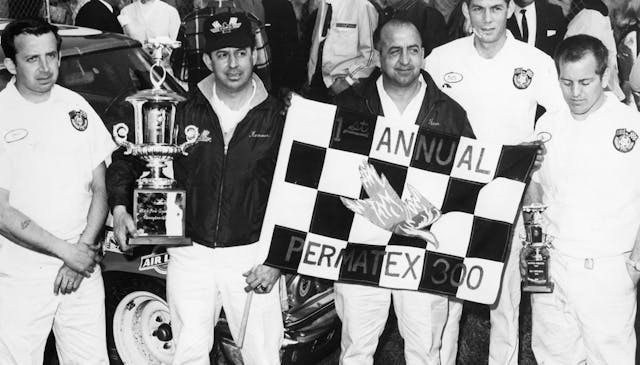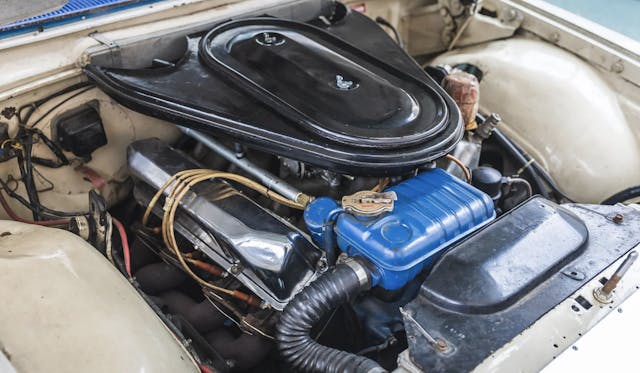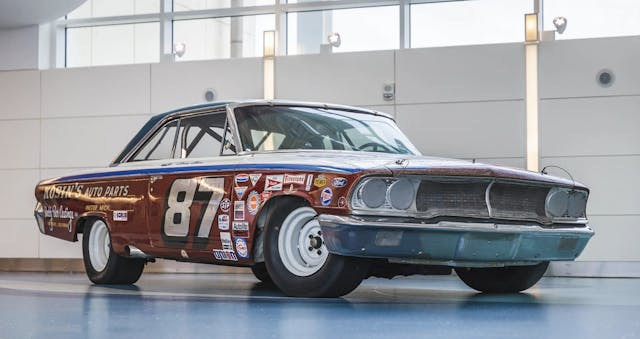This ’63 Galaxie Is What Happened When NASCAR’s Stars Aligned
This 1963 Galaxie, built as part of a pilot program for new models, was the star of Ford brochures. The hand-built early model was never destined to be sold to the public. Instead, it was photographed to highlight the new model’s sleek lines and powerful V-8 engines. But it’s more than just a pretty face. This car got a second lease on life when Jim “Hammer” Mason saw its potential. Mason, the aftermarket performance products manager at Dearborn Steel Tube, saw an opportunity to turn an otherwise unusable car into a racer.
Dearborn Steel Tubing Company had worked with Ford to build show cars and drag racers throughout the 1960s. The company owes its name to the fact that it supplied performance exhaust systems for high-performance Fords of the ’60s. The connections Mason had brokered at Ford left him in a position to take the neglected Galaxie and build it into a 427-powered speedway menace.

The car’s inaugural race was the 1966 Permatex 300, at Daytona International Speedway. The Modified/Sportsman event featured privateer drivers typically running racecars from previous years. Of course, they updated the powertrains to keep up. With hotshoe Curtis Turner behind the wheel, the car charged to the lead and took the checkered flag. Competitors in the race included Ralph Earnhart (Dale’s father), Bobby and Donnie Allison, Cale Yarborough, LeeRoy Yarbrough, and a young Darrell Waltrip.
The Galaxie would go on to race in four more Permatex 300 races at Daytona. In 1967 it took either seventh or eighth, depending on who you ask, again with Curtis driving. Bobby Allison, presumably tired of seeing the car’s non-existent taillights, took over driving duties for 1968. He earned a podium spot by finishing third. In 1969, his brother, Donnie, took over driving duties and finished eighth. The car’s final race, in 1970, saw Donnie earning a third-place finish after starting 17th.
It’s in that 1970 condition, with the same interior, the same gauges, and the same tires that Donnie Allison ran to a third-place finish, that the car still stands. Just as important, the car’s 427 V-8 is intact, all the way from its oil pan to its innovative cowl-induction air cleaner.

So how was a 1963 car, with 1963-level aerodynamics, able to compete with newer, sleeker body styles? Aside from the well-built nature of the car, it had input from legendary Ford V-8 hot-rodder Donnell “Pop” Sullivan. Sullivan was known for getting tremendous power out of production engines. Ford’s FE engines got off to a rather mundane start powering family sedans, wagons, and pickup trucks.
Once they began to churn out serious power and make their mark in the performance world, one shortcoming manifested. The engine’s oiling system prioritized the cam bearings. That meant pressurized oil took a long path before finally reaching the crankshaft main bearings. That might not be a problem in normal usage, but in a racing environment, where engines can be asked to run at full throttle for long intervals, stresses are much more significant.
To remedy the situation, Ford designed an oil passage that ran along the side of the deep-skirt block. This time it fed the main bearings first. Thus, the side-oiler was born. Not all 427s were side-oilers, but all side-oilers were 427s.


These 427 side-oilers would go on to win at dragstrips across the country, at NASCAR super speedways, and on the world stage at the 24 Hours of Le Mans. However, few of those winning cars with their snorting and thumping FE V-8s have remained in their as-raced state.
This phenomenal, untouched example of ’60s NASCAR technology will be at Broad Arrow’s Amelia Island sale. We’ll be watching to see where this time capsule of a racer ends up. Our fingers are crossed that we’ll see it on track in the future.

***
Check out the Hagerty Media homepage so you don’t miss a single story, or better yet, bookmark it. To get our best stories delivered right to your inbox, subscribe to our newsletters.



The 63 and a half Galaxie was just a good race car from 63 and on. It has decent aero and it had a good engine.
Aero was not as important back then as it is today. The chassis were all pretty similar in this era as they used the Galaxie pan and later the Chevy truck arms for suspensions.
These cars were getting away from being stock in this era much more than people realize.
Just a quick note, its Cale Yarborough and LeeRoy Yarbrough.
Good catch, thank you. I’ve made the edit.
There was Cale and LeeRoy , Donnie and Bobby. Cale and Donnie crashed each other out and had ” the fight ” at Daytona in 79 . Bobby joined the maylay. Petty then won. Bobby then won in ? followed by his son Davey in second and..I know that much but I’ve never ever seen or heard of this car. – Cool, thanks
FE Fords were NEVER record setters at NHRA events! 390 ci to 406 ci to 427 ci won a few but that was very few!
Ford Thunderbolts won NHRA Super Stock Championship in 1964 with 427 FE engines and in 1967 won Super Stock Championship with 428 Cobra Jet Mustangs just to keep things in same era.
One of the “few”:
Super Stock N/Automatic 64 Ford Custom 500 with a 250 H.P. 352 …
https://www.fordfe.com/super-stock-352-t70238.html
It’s Earnhardt, not Earnhart.
IIRC, that would be a “63 1/2” model with that roofline, which as the story goes was an aero development straight from the racetrack; and it was very helpful…until Chrysler Corp showed up in Feb ’64 with a fleet of Hemis, and a somewhat similar roofline. With a rake (nose lower than tail), the more angle the rear window has, more air flows over the trunklid, reducing drag and adding downforce.
The Galaxie is a great looking and performing car of the era. I love them.
Interesting that the ’64 Hemi engine was an “over the counter purchase” option – you could not buy it in a car until ’66. So Ford, likewise, tried an “over the counter option for it’s SOHC 427 in ’64. nASScar said, “No! It’s not stock!”.
I never completely understood that, nor the mid-size “B” bodies Mopars had at the time vs. full-size bodies GM and Ford ran………(?)